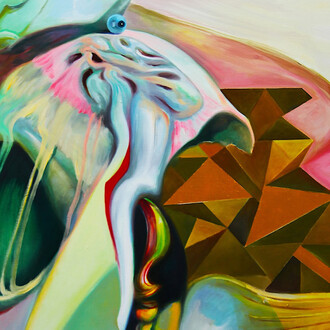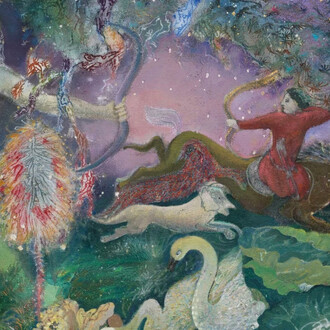Freight and Volume presents Strange mythopoetic fragments... an exhibition of paintings by Rose Briccetti. The show opens September 14th and runs through October 12th. This is Briccetti’s first solo exhibition with the gallery.
The works of Rose Briccetti straddle a line between naturalistic observation and painterly artifice. Briccetti digitally amasses her imagery, only to then redescribe the tableaux they create by the more traditional means of painting. Between the screen and the canvas a translation take place, which is not unlike what happens when you run a text through Google Translate. Misnomers and absurdities might crop up, as one language is algorithmically substituted for another; but somehow there's a surreal poetry to these mistakes. In a similar vein, Briccetti's paintings cultivate the surreal and the comical. They’re equally assemblages binding together the cultural detritus of our times, and studies of social movements reflected in the image stream of online culture.
The figures and objects that populate Briccetti’s canvases often take on a symbolic aspect. In Dangling the carrots (Daucus carota) (2020), for example, the contraceptive properties of the wild carrot (which has been used as an anti-fertility drug since antiquity) imagistically comb through a host of images, creating an intricate web of feeling that pushes the comic into a disturbing realm of nightmare. The phrase “bare no fruit”, the sterility of anti-fertility generally, haunts ordinary objects like a juice box of Hi-C, or a person masked by a rabbit costume, or even an arrangement of vegetables modeled to look like male genitalia. We see all these representative items in a new light, bent by the gravity of the wild carrot's secret history.
The theme of infertility carries over into another work on view: Bougainvillea and Reverse-drag triptych (2018). Here, the Bougainvillea features clandestinely in the work, its unique coloring and history vining through the many symbols, objects, and figures, occupying each canvas. The triptych form itself is something like a storied amber that captures different aspects of the Bougainvillea—from its unlikely discovery by Jeanne Baret, to allusions to the nomenclatures scientists use to categorize species, to more personal invasions of vine and plant life, such as what Briccetti observed when a vine happened to grow through a gap in her apartment door. Through all these associations the ubiquity of repression is univocally signified: whether this be how a woman has to hide her sex to make botanical discoveries, or a reversing of the logic of fertility.
Moving between observation and invention, digital landscapes and acrylics on canvas, Briccetti remixes some of the more troubling aspects of our culture in a manner which is both instructive and entertaining. Starting with seemingly familiar imagery, she'll place her figurations into contexts that actually point back to their historical origins. However fantastical her painting might appear, this derives more from the actual persons and objects she recreates, than from any willed intervention on the part of the artist. In this way, Briccetti serves up a naked lunch of surrealist proportions—making us rethink the (dis)connection between our hegemonic cultura signifiers and the shared, collective environments that sustain us.
















